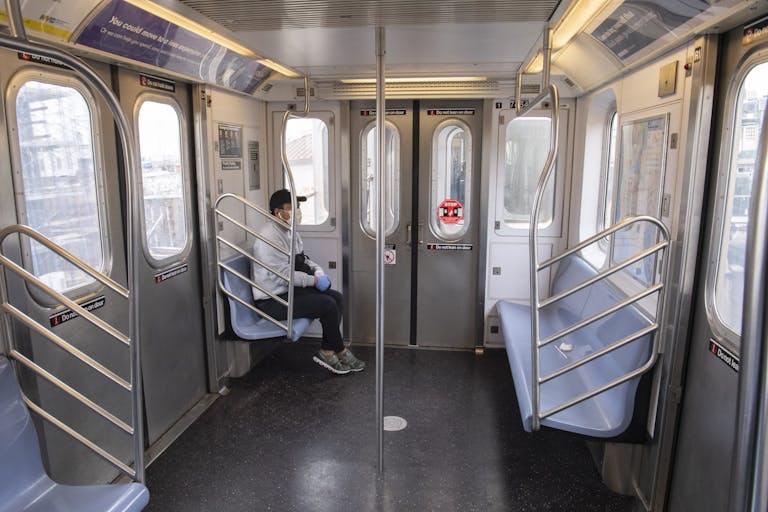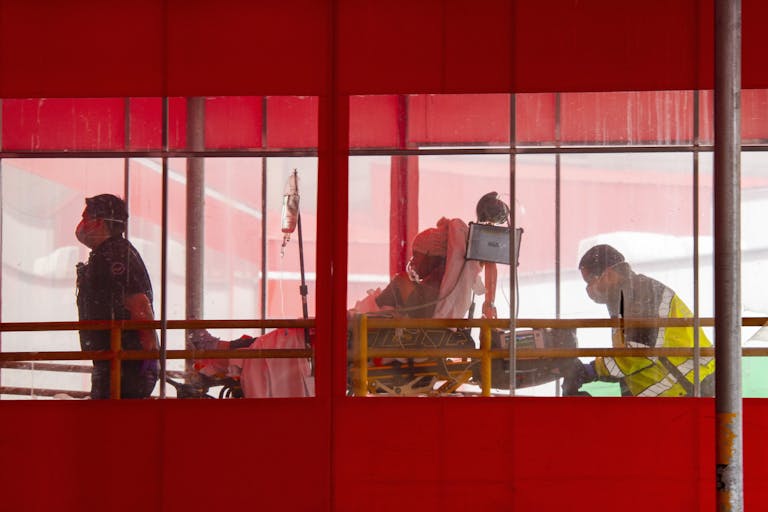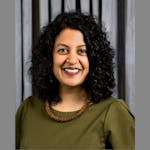The H1N1 pandemic changed the course of Dr. Purvi Parikh’s career.
When it broke out in 2009, the so-called swine flu became the first global flu pandemic in 40 years, ultimately killing more than 18,000 people worldwide. At the time, Dr. Parikh was working as a medical resident at the Cleveland Clinic, one of the trial sites for the H1N1 vaccine. The testing was led by Dr. Anthony Fauci, head of the National Institute of Allergy and Infectious Diseases who coordinates vaccine research at the National Institutes of Health. The experience led her to the field of immunology and a passion for supporting vaccine access.
In 2017, she channeled this expertise into advocacy by traveling to Zambia with the United Nations Foundation’s Shot@Life campaign, a grassroots group that raises awareness and resources for global immunization programs.
As the COVID-19 pandemic has revealed, vaccines are a vital global health tool — yet one that is too often misunderstood, underfunded, or inaccessible for the most vulnerable families.
Globally, a child dies of a vaccine-preventable disease every 20 seconds.

I spoke with Dr. Parikh about what she’s experiencing as a doctor in New York City — the U.S. epicenter of the COVID-19 pandemic — and why protecting access to all vaccines will be crucial for stopping the spread.
Can you paint a picture of what you’re experiencing as a doctor in the epicenter of the COVID-19 pandemic?
I hear sirens around the clock. It’s all day and all night, 24/7, which obviously isn’t normal for any city.
This crisis is completely different than anything I’ve ever experienced before. And all of my colleagues say the same thing — even doctors who’ve been doing this a long time, 30 years. They all say the same thing: This is unlike anything they’ve ever seen before.
So many healthcare workers are getting affected here in New York City. It’s to the point where I’m hearing about a physician or nurse dying of COVID-19 every day. If we lose our healthcare workforce, who’s going to take care of all the patients? That’s definitely causing a lot of stress and concern to me.
We know this is happening in other countries too — that healthcare workers have a much higher rate of getting sick and dying because they’re exposed to the virus constantly. As a doctor, when I hear about physicians, nurses and other people in the medical community passing away, it hits even closer to home.
What do you think would surprise people about what you’ve witnessed in New York as an immunologist on the front lines of this pandemic?
This virus is unlike what we’ve seen before. Two people can present so differently. One person barely has any symptoms while the other person is at death’s door and we can’t discern why. Initially, we thought the virus was more deadly to elderly people or people with multiple medical problems. But now we’re seeing even very young, healthy people become very badly affected.
The good news is the majority of people in New York and globally are either recovering at home or they’ve recovered in the hospital.
But those who do get very sick — that death toll is very real.
I can speak to it myself because I know people who have passed away. It’s surreal. These are people I saw maybe a month before their passing. Family friends I saw at my wedding seven months ago are now on a ventilator fighting for their lives. I personally know five people who have died of COVID-19, including the husband of one of our nurses who was just 32 years old.
How has the pandemic changed your day-to-day?
I work at a private practice that sees allergy, asthma, and immunology patients. I’m also on staff in the immunology and infectious disease department at NYU Langone Hospital so we’re right in the middle of the epicenter.
My patients are definitely high-risk for COVID-19 because I treat people who already have a poorly functioning immune system to begin with. I also treat asthmatics and we know this virus attacks the lungs so it’s a very high anxiety time for the people I treat.
To make matters even more confusing, right now is the peak pollen season throughout most of the Northeast and many parts of the country. It’s a notorious time for people to suffer from asthma attacks and other symptoms that can resemble COVID-19.
Most of the hospitals, not just NYU Langone, have multiple COVID units and everybody is pitching in. It’s all hands on deck. In the pediatric ICU, for example, normally it’s only for patients 18 years old or younger, but now they’re even holding patients as old as 30 because we need more space.
It’s very unique to any other infectious outbreak that we’ve dealt with because it is so highly contagious. So in our private practice, we’re limiting the amount of people who come in to emergencies only. We want to be available for patients who are having an acute asthma attack so they can avoid being exposed at the hospital, which are hot zones right now.
At the same time, a lot of our patients rely on various immune treatments on a weekly or monthly basis so stopping those treatments would then make their allergic and asthmatic disorders go out of control, which then puts them at an even higher risk for COVID-19. So some of those treatments have to continue. So it’s an added challenge because we want to keep our patients safe and not expose them, but we also have to keep our staff and ourselves safe.
What challenges have you and your colleagues faced responding to the COVID-19 outbreak in NYC?
Personal protective equipment is a big issue. Almost everyone I know unfortunately is re-using equipment in some way or form — myself included. I have a couple of N-95 masks that I’ve been rotating myself.
For those who are in hospital environments where they’re seeing a high load of COVID-19 patients for hours and hours at a time, it’s not really the best practice to reuse a mask that’s meant to be discarded after each patient.
Ironically, I found out the reason why the shortage occurred is because of the H1N1 pandemic. Apparently, a lot of these masks and equipment were used up then and the supplies were never replenished — even though that pandemic was almost a decade ago. So, unfortunately, this pandemic hit the U.S. when we were very unprepared — not just from the testing standpoint, but the personal equipment standpoint.

Myself and a few other community members have been working to get personal protective equipment out to various hospitals by working with a 3-D printing company so seeing creative ways for the community to come together and address this shortage is great. But at the same time, doctors shouldn’t have to source our own supply.
The problem is we still need more widespread testing to give us information on when it’s safe to stop social distancing as aggressively. Right now we don’t know how many people are exposed currently, how many people have developed immunity at this point. We don’t really have any good at-home testing, which is what we really need because many people who are asymptomatic may actually be infected and have the capability to spread the virus. That’s the other scary thing — there’s a lot of asymptomatic carriers.
And then the speed at which we’re getting results back has also been very slow, especially for healthcare workers. My colleagues in the emergency rooms and ICU — if they get sick, they don’t know when it’s safe for them to go back to work or not because many of them are waiting up to a week until they get a test result, which is far too long. So that’s a problem.
For those who aren’t familiar with UNICEF’s global work in vaccines or WHO’s role in global health, how would you describe these agencies and why it’s so important to maintain support for the global pandemic response?
I’ve seen UNICEF’s work firsthand in Zambia. The parents I met viewed these vaccines as a gift. They had seen too many children die of diseases that could’ve been prevented. UNICEF vaccinates nearly 45% of the world’s children, which is just an astounding figure.
Given what we’ve already seen with COVID-19, I think it underscores how important UNICEF and WHO’s work is because we rely on these agencies for global responses — and this is a truly global crisis. The saying “an outbreak anywhere is an outbreak everywhere” could not ring more true today. Every country has their own contingency plan, but we need one unifying body to take in data and collect on-the-ground reports from everywhere. That’s how we learn — especially with a brand-new virus that none of us have ever seen before.
We have the challenge of treating this virus and learning about it at the same time. So WHO’s work is extremely important in not only educating our medical community, but also helping coordinate responses around the world and reporting back to us what works and what doesn’t. I think now more than ever, we do need unity and an overarching organization like WHO.
What would you tell other Americans about why we need to support a global response and not just a U.S. one?
Too often people feel like they’re in their own bubble and think, “Well, problems that are far from me don’t really affect me.”
But as we’ve seen with any infectious disease and now with globalization and international travel, these problems can end up in your backyard at any given time. So it really does take a concerted global effort.
And looking ahead, we’ll need WHO and UNICEF to make sure everyone has access to vaccines, medications and other lifesaving treatments to COVID-19.
Earlier this month, the WHO warned that COVID-19 is putting some 117 million children worldwide at risk of missing the measles vaccine due to a lack of access because of the virus.
Can you talk about the risks that these other contagious diseases pose and why investing in health infrastructure and access to vaccines more broadly — versus focusing resources solely on COVID-19 — is so important?
It’s huge because if parts of the globe lose access to these life saving vaccines, all of us are in trouble. It’s not just a humanitarian issue. If we are having outbreaks of measles and other infectious communicable diseases when we’re already overwhelmed by COVID-19, healthcare systems will collapse.
It’s already very, very challenging just to take care of one COVID-19 patient compared with other types of patients that also have equally life-threatening emergencies. Treating these patients is very labor-intensive and equipment-intensive because you have to be careful with protective equipment and what you’re using and reusing. Just with that alone, this pandemic has already caused such a strain on our healthcare system.
So if you throw another outbreak on top of that, I’m scared to even think about it. Now is definitely not the time for millions of people to lose access to existing vaccines because we cannot afford multiple infectious disease outbreaks. None of our global health systems have the bandwidth for that right now.
The New York Times published a piece about how the global scientific community is coming together to fight this coronavirus in unprecedented ways. How have you experienced this as a doctor in the epicenter?
Diseases don’t know borders or countries or political agendas — diseases affect all humans the same. I know doctors like me are collaborating on a daily basis: Sharing experiences, studies and protocols, even utilizing Facebook and social media to share these experiences and data. I’m in multiple international COVID physician groups myself. Many of the discussions are clinical: Are you seeing this presentation versus that? What treatments are effective in these scenarios? Because each patient presents so differently, it’s very helpful to hear from colleagues around the world about how they manage each scenario. I personally have learned so much about this disease.
Some somber parts of these COVID groups is that we also honor our fallen colleagues, which is always heartbreaking every time I see that another healthcare worker has passed.
Many also use these forums to see if colleagues can help or check on their friends or family who have been admitted at various hospitals as visitors aren’t allowed and most hospital staff is too inundated and overwhelmed to give updates. One especially heart-wrenching plea came on last Monday night: A colleague was asking if another medical worker could go hold her grandfather’s hand so he didn’t die alone in the hospital he was at.
This exchange of information, discussion of cases, and camaraderie is nothing new — physicians always operate this way. Whenever we see a patient even on a normal day, we know nothing about their background, financial status, or political agenda. We are trained and taught to treat everyone the same and unite behind the common goal of getting that person better — whether they are a president or a prisoner.
Now we are just doing it on a global scale with the common goal of healing humanity.
As of April 22nd, WHO has shipped more than 2.5 million surgical masks and 1.6 million gloves to 133 countries across the planet, along with 1.5 million testing kits. The agency is also working with more than 100 countries to coordinate and accelerate treatment and vaccine research. Working alongside WHO, UNICEF is helping protect the most vulnerable families from the ongoing crisis by protecting access to water, sanitation, and hygiene.
Get INvolved
You can support WHO and UNICEF’s work to stop the spread by giving to the COVID-19 Solidarity Response Fund. Donations made via Facebook will be matched up to $10,000,000. Through June 30, 2020, for every $1 you donate here, Google.org will donate $2, up to $5,000,000.
With more than 350,000 supporters like Dr. Parikh in all 50 states, Shot@Life is a grassroots advocacy campaign of the United Nations Foundation that champions global childhood immunization by supporting the work of UNICEF, WHO, and Gavi, the Vaccine Alliance.
To learn how you can join the Shot@Life movement, visit ShotAtLife.org.



 View All Blog Posts
View All Blog Posts


